Low-Flying Aircraft Will Collect Air Samples For Analysis
During September, Houston area residents might notice a large white and blue airplane flying at low altitude occasionally making low spirals. You might be able to see the NASA logo on the aircraft tail. The 117-foot-long NASA P-3B research aircraft is equipped with instruments studying air pollution as part of a mission to help scientists better understand how to measure and forecast air quality from space.

NASA is conducting the field study throughout September, based at NASA Johnson Space Center's Ellington Field. The four-engine P-3B turboprop from NASA's Wallops Flight Facility in Wallops Island, Va., will carry eight instruments. A two-engine B200 King Air aircraft from NASA Langley Research Center in Hampton, Va., will carry two instruments. The flights are part of NASA's larger, five-year Deriving Information on Surface conditions from Column and Vertically Resolved Observations Relevant to Air Quality (DISCOVER-AQ) study, which uses a network of observations including high-flying aircraft and ground sites.
Researchers are working to improve the ability of satellites to consistently observe air quality in the lowest part of the atmosphere. If scientists can better observe pollution from space, they will be able to improve air quality forecasts and better, determine where pollution is coming from and why emissions vary. A fundamental challenge for space-based instruments monitoring air quality is to distinguish between pollution high in the atmosphere and pollution near the surface.
"DISCOVER-AQ is collecting data that will prepare us to make better observations from space, as well as determine the best mix of observations to have at the surface when we have new satellite instruments in geostationary orbit," said NASA Langley's James Crawford, the mission's principal investigator. "NASA is planning to launch such an instrument, called TEMPO, in 2019."

Because many countries, including the U.S., have large gaps in ground-based networks of air pollution monitors, experts hope satellites can provide a more complete geographic perspective on the distribution of pollutants. A fleet of Earth-observing satellites, called the Afternoon Constellation or "A-train," will pass over the DISCOVER-AQ study area early each afternoon. The satellites' data, especially from NASA's Aqua and Aura spacecraft, will allow scientists to compare the view from space with that from the ground and aircraft. "It's been useful in giving us a broader view of air pollution than we've ever had before," said Kenneth Pickering, DISCOVER-AQ project scientist at NASA's Goddard Space Flight Center in Greenbelt, Md. "DISCOVER-AQ will help scientists interpret that data to improve air-quality analysis and regional air quality models."
The DISCOVER-AQ mission is a partnership with the U.S. Environmental Protection Agency and National Oceanic and Atmospheric Administration.
(Map, P-3 image provided by NASA)
 ANN's Daily Aero-Term (04.20.24): Light Gun
ANN's Daily Aero-Term (04.20.24): Light Gun Aero-News: Quote of the Day (04.20.24)
Aero-News: Quote of the Day (04.20.24) ANN's Daily Aero-Linx (04.21.24)
ANN's Daily Aero-Linx (04.21.24) Aero-News: Quote of the Day (04.21.24)
Aero-News: Quote of the Day (04.21.24) ANN's Daily Aero-Term (04.21.24): Aircraft Conflict
ANN's Daily Aero-Term (04.21.24): Aircraft Conflict




